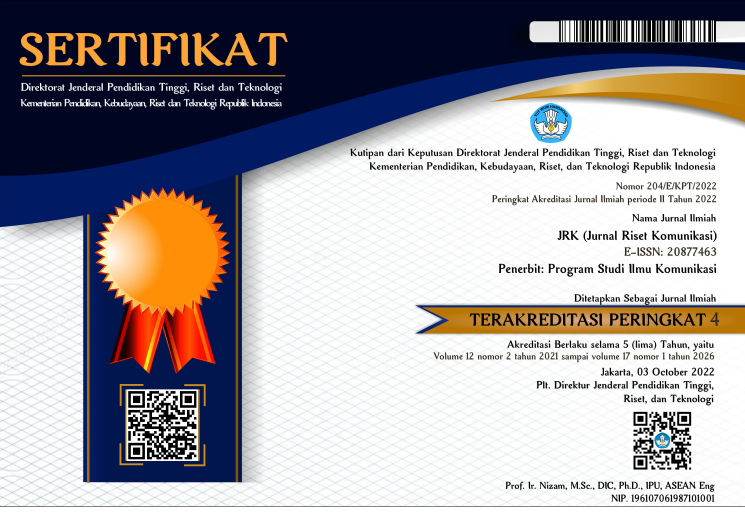MENGUKUR DAN MEMAHAMI SOCIAL NETWORK ANALYSIS BNPT DALAM MENGKONTER NARASI TERORISME ONLINE
Abstract
Full Text:
PDFReferences
Asongu, S. A., Orim, S. M. I., & Nting, R. T. (2019). Terrorism and social media: global evidence. Journal of Global Information Technology Management, 22(3), 208-228.
Aly, A., Macdonald, S., Jarvis, L., & Chen, T. M. (2017). Introduction to the special issue: Terrorist online propaganda and radicalization. Studies in Conflict & Terrorism, 40(1), 1-9.
Barberá, P. (2015). Birds of the same feather tweet together: Bayesian ideal point estimation using Twitter data. Political analysis, 23(1), 76-91.
Beale, S. (2018). Online Terrorist Speech, Direct Government Regulation, and the Communications Decency Act. Duke Law & Technology Review, 16(1), 333–350.
Davis, P. K., Larson, E. V., Haldeman, Z., Oguz, M., & Rana, Y. (2012). Understanding and influencing public support for insurgency and terrorism. RAND National Defense Research Inst Santa Monica CA.
Edosomwan, S., Prakasan, S. K., Kouame, D., Watson, J., & Seymour, T. (2011). The history of social media and its impact on business. Journal of Applied Management and Entrepreneurship, 16(3), 79–91.
Enders, W., & Sandler, T. (2006). Distribution of transnational terrorism among countries by income class and geography after 9/11. International Studies Quarterly, 50(2), 367-393.
Golovchenko, Y., Hartmann, M., & Adler-Nissen, R. (2018). State, media and civil society in the information warfare over Ukraine: citizen curators of digital disinformation. International Affairs, 94(5), 975-994.
Giuffre, K. ( 2013). Communities and Networks: Using Social Network Analysis to Rethink Urban and Community Studies. Malden, MA: Polity Press.
Hossain, M. S. (2015). Social media and terrorism: threats and challenges to the modern era. South Asian Survey, 22(2), 136-155.
Huda, A. Z., Runturambi, A. J. S., & Syauqillah, M. (2021).
Social Media as An Incubator of Youth Terrorism In Indonesia: Hybrid Threat and Warfare. Jurnal Indo-Islamika, 11(1), 21-40.
Jain, P. N., & Vaidya, A. S. (2021). Analysis of social media based on terrorism—a review. Vietnam Journal of Computer Science, 8(01), 1-21.
Kaplan, A. M., & Haenlein, M. (2010). Users of the world, unite! The challenges and opportunities of Social Media. Business horizons, 53(1), 59-68.
Lim, M. (2013). Many Clicks but Little Sticks: Social Media Activism in Indonesia. Journal of Contemporary Asia, 43(4), 636–657.https://doi.org/10.1080/00472336.2013.769386
Mahony, L. M., & Tang, T. (2017). Strategic Social Media. West Sussex: Willey Blackwell
Moleong, Lexy J. (2013). Metode Penelitian Kualitatif. Bandung: PT. Remaja Rosdakarya. Hal 6
Montoya, J. W., & Hofstetter, F. (2014). ISIL’s Utilization of Multimedia to Fulfil Their Quest of Creating a New Islamic State.
Parker, T., & Sitter, N. (2016). The four horsemen of terrorism: it's not waves, it's strains. Terrorism and Political Violence, 28(2), 197-216.
Tsesis, A. (2017). Social media accountability for terrorist propaganda. Fordham L. Rev., 86, 605.
DOI: http://dx.doi.org/10.31506/jrk.v14i1.19471
Refbacks
- There are currently no refbacks.









